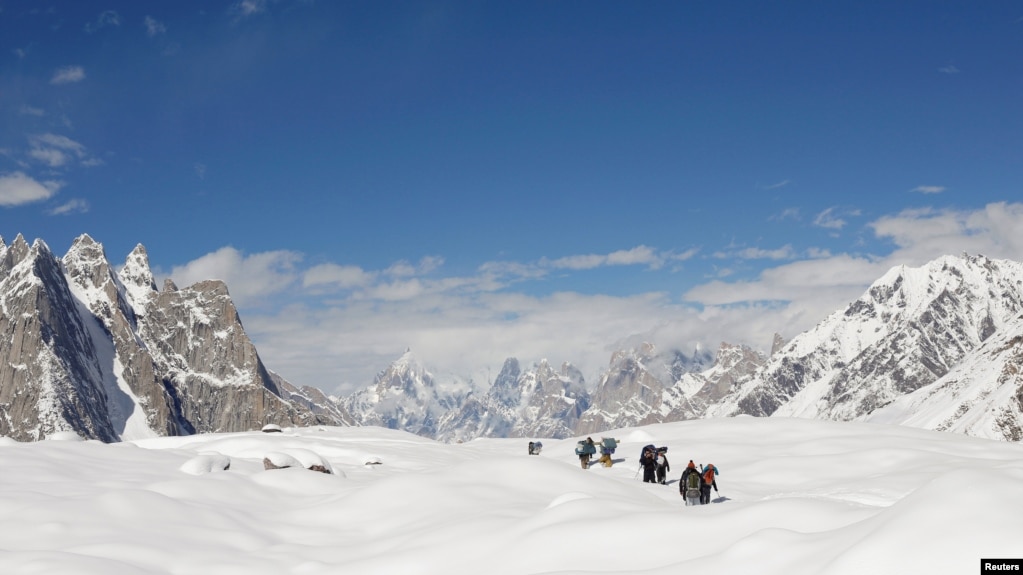
People hike down the Baltoro glacier in the Karakoram mountain range in Pakistan September 7, 2014. REUTERS/Wolfgang Rattay/File Photo
At least one-third of the ice in the Himalayan Mountains will disappear by the end of this century because of rising temperatures, scientists said this week. This will threaten river flows that provide water resources for 1.9 billion people.
Huge glaciers make the Hindu Kush Himalaya area the planet's so-called “third pole” behind Antarctica and the Arctic. The area is home to the world’s highest mountains. It stretches 3,500 kilometers across Nepal, Bangladesh, Bhutan, Afghanistan, Pakistan, China, India and Myanmar.
The Hindu Kush Himalayan Assessment was released on Monday. The Nepal-based International Centre for Integrated Mountain Development, or ICIMOD, carried out the five-year report. It is one of the largest-ever studies on warming in mountain areas. More than 200 experts helped write the report.
“This is the climate crisis you haven’t heard of,” said Philippus Wester, who led the report.
Wester said climate change is set to turn cold, ice-covered Himalayan mountains to bare rocks by the year 2100.
Himalayan glaciers feed 10 major rivers, including the Yangtze, Ganges and the Indus. Farmers living in the area use glacial melt water for their crops in the dry season. About 250 million people live in the mountains. Another 1.65 billion people live in river valleys below.
Changes in river flows could also harm hydropower production and cause more landslides in the mountains.
Along with global warming, air pollution is also affecting the area, the study found. The Hindu Kush includes an area called the Indo-Gangetic Plains – one of the most polluted places in the world. Air pollutants like black carbon and dust land on the glaciers, which speeds up their melting, too.
The report said that one-third of the ice will melt by 2100 even if governments worldwide meet goals set by the 2015 Paris climate agreement to limit global warming.
But if governments fail to limit greenhouse gas emissions, about two-thirds of ice in the Himalayas could disappear by 2100.
Wester told the Reuters news agency, “To me this is the biggest worrying thing.”
The study said governments in the region must change their existing agriculture systems, prepare for droughts and put up early flood warning systems.
The report’s writers noted that people living in small island states are often considered to be the most vulnerable to climate change because of rising sea levels. But Dasho Rinzin Dorji, who is with ICIMOD, said mountain areas such as the Himalayas are also extremely vulnerable “climate hotspots.”
“It’s not just occupants of the world’s islands that are suffering,” he said.
David Molden is director of ICIMOD. He added, “Mountain people are really getting hit hard….We have to do something now.”
I’m Ashley Thompson.
The Reuters news agency reported this story. Susan Shand adapted it for VOA Learning English with additional materials from VOA News. Ashley Thompson was the editor.
_____________________________________________________________
Words in This Story
glacier - n. a very large area of ice that moves slowly down a slope or valley or over a wide area of land
assessment - n. an idea or opinion about something
bare - adj. not having a covering
hydropower - n. electricity produced from machines that are run by moving water
vulnerable - adj. open to harm or damage
greenhouse - adj. relating to or caused by the warming of the Earth's atmosphere that is caused by air pollution : relating to or caused by the greenhouse effect
emission - n. the act of producing or sending out something (such as energy or gas) from a source
Comprehension Quiz
What could changes in river flows also harm?